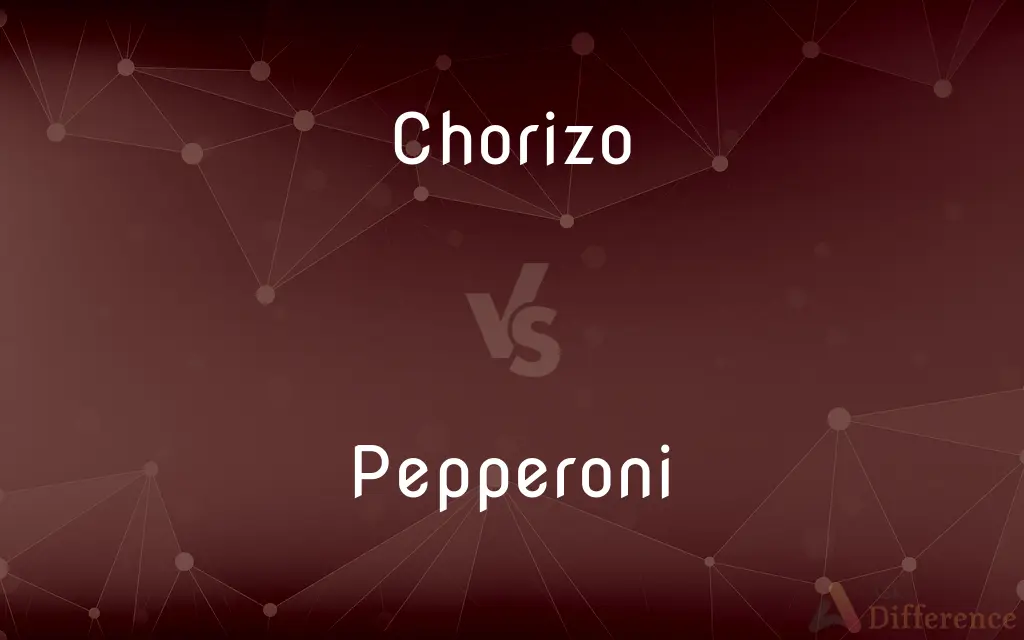Chorizo vs. Pepperoni — What's the Difference?
By Maham Liaqat & Urooj Arif — Updated on April 2, 2024
Chorizo is a spicy pork sausage from the Iberian Peninsula; pepperoni is an American salami, milder and used on pizza.

Difference Between Chorizo and Pepperoni
Table of Contents
ADVERTISEMENT
Key Differences
Chorizo, originating from the Iberian Peninsula, is a type of pork sausage known for its deep red color and robust, spicy flavor, achieved through the liberal use of smoked paprika. It is a versatile ingredient in many traditional dishes, from stews to tapas. On the other hand, pepperoni is a type of American salami made from cured pork and beef mixed with paprika or other chili pepper, giving it a softer, slightly smoky, and less spicy taste compared to chorizo. Pepperoni is famously used as a pizza topping but also enjoyed in sandwiches and as part of antipasto platters.
The preparation and serving of chorizo can vary; it can be found both fresh, requiring cooking, and cured or smoked, ready to be eaten as is. This contrasts with pepperoni, which is almost always cured and sliced thin to serve on pizza or eaten directly from the package. Chorizo's flavor profile is heavily influenced by the type and amount of paprika used, which can range from sweet to hot, while pepperoni's flavor is generally consistent, characterized by a balance of savory, spicy, and smoky notes.
Another key difference lies in their cultural significance and culinary uses. Chorizo is integral to various Spanish and Portuguese cuisines, reflecting the rich culinary traditions of the Iberian Peninsula. It is celebrated in numerous regional dishes and enjoyed in diverse ways, from being included in breakfast meals to serving as a critical ingredient in complex entrees. Pepperoni, although it originated from Italian-American cuisine, has become synonymous with American food culture, particularly as the most popular pizza topping in the United States.
The texture of chorizo and pepperoni also differs due to their ingredients and processing methods. Chorizo typically has a more coarse texture, reflecting its artisanal roots, whereas pepperoni is smoother, a result of being finely ground and emulsified before being stuffed into casings. This distinction influences how they integrate into dishes, with chorizo often providing a meatier bite and pepperoni melting more uniformly into pizzas and baked goods.
Comparison Chart
Origin
Iberian Peninsula (Spain/Portugal)
United States (Italian-American)
ADVERTISEMENT
Main Ingredients
Pork, smoked paprika
Pork and beef, paprika or chili pepper
Flavor
Spicy, can range from sweet to hot
Slightly spicy, smoky, less intense than chorizo
Usage
Stews, tapas, sandwiches, alone
Pizza topping, sandwiches, antipasto
Texture
Coarse, varies by preparation
Smooth, finely ground
Preparation
Fresh (needs cooking) or cured/smoked (ready to eat)
Cured, ready to eat
Culinary Significance
Integral to Spanish and Portuguese cuisines
Synonymous with American pizza
Compare with Definitions
Chorizo
Can be fresh or cured, influencing its cooking uses.
Fresh chorizo must be cooked thoroughly before eating.
Pepperoni
Known for its soft, slightly smoky flavor.
The pepperoni added a subtle smokiness to the sandwich.
Chorizo
Celebrated for its versatility in cooking.
Chorizo is used in everything from soups to grilled tapas.
Pepperoni
Almost always cured and served thin.
Thinly sliced pepperoni crisps up perfectly on pizza.
Chorizo
A spicy pork sausage flavored with smoked paprika.
Chorizo adds a robust flavor to the paella.
Pepperoni
An American salami made from a mix of pork and beef.
Pepperoni is the most requested pizza topping in the U.S.
Chorizo
Integral to many traditional Iberian dishes.
For breakfast, they enjoyed eggs with slices of spicy chorizo.
Pepperoni
Appreciated for its balance of savory and spicy notes.
The spiciness of the pepperoni complemented the creamy cheese.
Chorizo
The spice level can vary significantly.
She preferred the milder version of chorizo for her stew.
Pepperoni
A staple in Italian-American cuisine.
An antipasto platter isn't complete without some slices of pepperoni.
Chorizo
Chorizo (, from Spanish [tʃoˈɾiθo]; similar to but distinct from Portuguese chouriço [ʃo(w)ˈɾisu]) is a type of pork sausage. In Europe, chorizo is a fermented, cured, smoked sausage, which may be sliced and eaten without cooking, or added as an ingredient to add flavor to other dishes.
Pepperoni
Pepperoni is an American variety of salami, made from cured pork and beef seasoned with paprika or other chili pepper.Pepperoni is characteristically soft, slightly smoky, and bright red in color. Thinly sliced pepperoni is a popular pizza topping in American pizzerias.
Chorizo
A spicy pork sausage seasoned especially with garlic.
Pepperoni
A highly spiced pork and beef sausage.
Chorizo
A spicy Spanish sausage flavoured with paprika, often crumbled for use in filling tacos, quesadillas, etc.
Pepperoni
A slice of this type of sausage.
Pepperoni
A spicy salami-style Italian-American sausage made from cured pork and beef seasoned with pepper.
Pepperoni
Pizza with only tomato sauce, cheese and pepperoni toppings.
Yo, Tony, gimme a slice of pepperoni and a coke.
Pepperoni
A hard sausage of beef and pork, highly seasoned.
Pepperoni
A pork and beef sausage (or a thin slice of this sausage)
Common Curiosities
Can pepperoni be made without beef?
Traditional pepperoni in the United States is made with both pork and beef, but variations exist, including all-pork versions.
How should fresh chorizo be stored before cooking?
Fresh chorizo should be stored in the refrigerator and cooked thoroughly before consumption.
What dishes are chorizo commonly used in besides paella?
Chorizo is used in a wide range of dishes, including stews, soups, tapas, and as part of breakfast meals.
Is there a vegetarian alternative to pepperoni?
Yes, there are vegetarian and vegan pepperoni alternatives made from plant-based ingredients.
Is chorizo always spicy?
Chorizo's spice level can vary from sweet to very spicy, depending on the type of paprika used.
Can chorizo be eaten without cooking?
Cured or smoked chorizo can be eaten without cooking, similar to salami, but fresh chorizo requires cooking.
Why is pepperoni so popular on pizza?
Its mild spiciness, smoky flavor, and ability to crisp up make pepperoni a favorite pizza topping.
How does the flavor of chorizo differ from that of Italian sausage?
Chorizo is generally spicier and more robust, primarily due to the smoked paprika, whereas Italian sausage often features fennel and is milder.
Can pepperoni be added to dishes other than pizza?
Absolutely, pepperoni is also popular in sandwiches, salads, and baked into bread or rolls.
What makes chorizo red?
The deep red color of chorizo comes from the smoked paprika used in its seasoning blend.
Why is pepperoni often slightly curled on pizza?
The edges of pepperoni tend to curl up and crisp when exposed to the high heat of a pizza oven, creating a characteristic cupped appearance.
Is it necessary to peel chorizo before cooking?
Some types of cured chorizo have a tough outer casing that should be removed before eating; however, fresh chorizo usually does not require peeling.
Can chorizo be frozen for later use?
Yes, both fresh and cured chorizo can be frozen, though fresh chorizo should be cooked within a few days after thawing.
How do you store leftover pepperoni?
Leftover pepperoni should be stored in the refrigerator and is best used within a week for optimal freshness.
What are some health considerations when consuming chorizo and pepperoni?
Both are high in fat and sodium, so they should be consumed in moderation, especially by those watching their dietary intake of these elements.
Share Your Discovery

Previous Comparison
Womanity vs. Womanhood
Next Comparison
Bimestrial vs. BimonthlyAuthor Spotlight
Written by
Maham LiaqatCo-written by
Urooj ArifUrooj is a skilled content writer at Ask Difference, known for her exceptional ability to simplify complex topics into engaging and informative content. With a passion for research and a flair for clear, concise writing, she consistently delivers articles that resonate with our diverse audience.















































